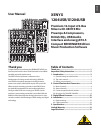
ENGLISH
XENYX 1204USB/X1204USB User Manual
8
ENGLISH
XENYX 1204USB/X1204USB User Manual
9
CD/TAPE
The TAPE switch routes the signal from the TAPE IN
connectors to the level meter, the CONTROL ROOM OUT
outputs and the PHONES connector this is a simple way to
check recorded signals via monitor speakers or headphones.
ALT 3-4
Similarly, the ALT 3-4 switch routes the signal from the
Alt 3-4 bus to the same path for monitoring purposes.
MAIN MIX
The MAIN MIX switch sends the main mix signal to the
above-mentioned outputs and to the level meter.
PHONES/CTRL R(oom)
Use this control to set control room output level and head-
phones volume respectively.
CD/TAPE TO MAIN
When the CD/TAPE TO MAIN switch is depressed, the 2-track
input is routed to the main mix and thus serves as an
additional input for tape machines. You can also connect
MIDI instruments or other signal sources here that do not
require any further processing. At the same time, this switch
disables the main mix to tape output link.
POWER
The blue POWER LED indicates that the device is switched on.
+48 V
The red “+48 V” LED lights up when the phantom power
supply is switched on. The phantom power supply is
necessary for condenser microphones and is activated
using the switch on the rear of the device.
Please do not connect microphones to the mixer ◊
(or the stagebox/wallbox) while the phantom power
supply is switched on. Connect micro-phones before
you switch on the power supply. In addition, the
monitor/PA loudspeakers should be muted before
you activate the phantom power supply. After
switching on, wait approx. one minute to allow
for system stabilization.
LEVEL METER
The high-precision level meter accurately displays the
appropriate signal level.
LEVEL SETTING:
When recording to a digital device, the recorder’s peak
meter should not exceed 0 dB. This is because, unlike analog
recordings, slightly excessive levels can create unpleasant
digital distortion.
When recording to an analog device, the VU meters of the
recording machine should reach approx. +3 dB with low-
frequency signals (e.g. kick drum). Due to their inertia VU
meters tend to display too low a signal level at frequencies
above 1 kHz. This is why, for example, a Hi-Hat should only
be driven as far as -10 dB. Snare drums should be driven
to approx. 0 dB.
The peak meters of your XENYX display the level virtually
independent of frequency. A recording level of 0 dB is
recommended for all signal types.
MODE (1204FX only)
The MODE switch determines whether the channels’
SOLO switch operates as PFL (Pre Fader Listen) or as solo
(Solo In Place).
PFL
To activate the PFL function, depress the MODE switch.
The PFL function should, as a rule, be used for gain setting
purposes. The signal is sourced pre-fader and assigned to the
mono PFL bus. In the “PFL” setting, only the left side of the
peak meter operates. Drive the individual channels to the
0 dB mark of the VU meter.
Solo
When the MODE switch is not depressed, the stereo solo bus
is active. Solo is short for “Solo In Place”. This is the customary
method for listening to an individual signal or to a group of
signals. As soon as a solo switch is pressed, all channels in the
control room (and headphones) that have not been selected
are muted thereby retaining stereo panning. The solo bus
can carry the output signals of the channel pan controls, the
aux sends and the stereo line inputs. The solo bus is, as a rule,
switched post-fader.
The PAN control in the channel strip oers a constant ◊
power characteristic. This means that the signal is
always at a constant level, irrespective of its position in
the stereo panorama. If the PAN control is moved fully
left or right from center, the level increases by 4 dB in
that channel. This ensures that, when set in the center,
the audio signal is not louder. For this reason, with the
solo function activated (Solo in Place), audio signals
from the channels with PAN controls that have not
been moved fully to the left or right are displayed at a
lower volume than in the PFL function.
As a rule, solo signals are monitored via the control room
outputs and headphones connector and are displayed by
the level meters. If a solo switch is pressed, the signals from
the tape input, Alt 3-4 and main mix are blocked from the
control room outputs, the headphone connector and the
level meter.
MAIN SOLO (1204FX only)
The MAIN SOLO LED lights up as soon as a channel or aux
send solo switch is pressed. The MODE switch also has to be
set at “Solo”.
PFL (1204FX only)
The PFL LED indicates that the peak meter
is set to PFL mode.
PHONES
You can connect headphones to this ¼" TRS connector.
The signal on the PHONES connection is sourced from the
control room output.
Alt 3-4 and main mix fader2.3.7
Use the high-precision quality faders to control the output
level of the Alt 3-4 subgroup and main mix.
Rear view of X1204USB/1204USB2.4
Main mix outputs, Alt 3-4 outputs and 2.4.1
control room outputs
MAIN OUTPUTS
The MAIN outputs carry the MAIN MIX signal and are on
balanced XLR connectors with a nominal level of +4 dBu.
ALT 3-4 OUTPUTS
The ALT 3-4 outputs are unbalanced and carry the signals
of the channels that you have assigned to this group using
the MUTE switch. This can be used to route a subgroup to a
further mixing console for example, or or it could be used as
a recording output working in tandem with the main output.
This means you could record to four tracks simultaneously.
The icing on the cake, so to speak, is that you could connect
Y-cables to these four outputs and then connect your
8-track recorder in such a way that you have 2 x 4 tracks (e.g.
channel 1 feeds track 1 and track 2, etc.). In the rst recording
pass, you record on tracks 1, 3, 5 and 7 and in the second
pass, on tracks 2, 4, 6 and 8.
CONTROL ROOM OUTPUTS
The control room output is normally connected to the
monitor system in the control room and provides the stereo
mix or, when required, the solo signal.
5.5 USB input/output
The XENYX mixer line has built-in USB connectivity, allowing
stereo signals to be sent to and from the mixer and a
computer. The audio sent from the mixer to a computer is
identical to the MAIN MIX. Audio being sent to the mixer
from a computer can be routed to the main mix with the
2-TR/USB TO MAIN button.
Connect the USB type B plug into the USB jack on the mixer,
and the other end into a free USB port on your computer.
There are no required drivers, but we recommend that PC
users install the included ASIO driver. The driver can also be
downloaded from www.behringer.com.
Voltage supply, phantom power and fuse2.4.2
FUSE HOLDER
The console is connected to the mains via the cable supplied
which meets the required safety standards. Blown fuses
must only be replaced by fuses of the same type and rating.
IEC MAINS RECEPTACLE
The mains connection is via a cable with IEC mains
connector. An appropriate mains cable is supplied with
the equipment.
Fig. 2.12: PHONES connector
Fig. 2.13: Alt 3-4 and main mix fader
Fig. 2.14: Main mix outputs, Alt 3-4 outputs and control room outputs
Fig. 5.5 USB input/output
Fig. 2.15: Voltage supply and fuse












